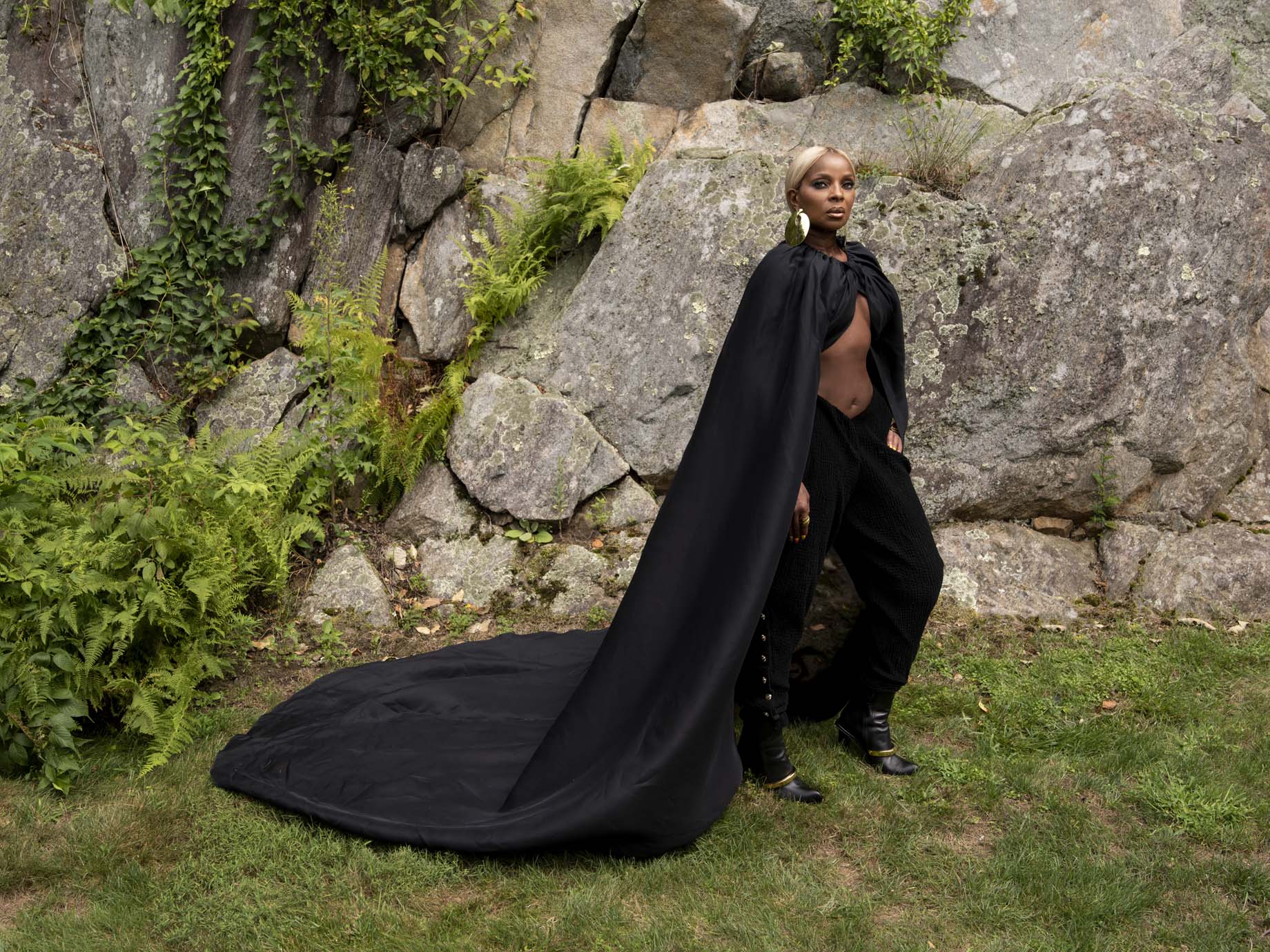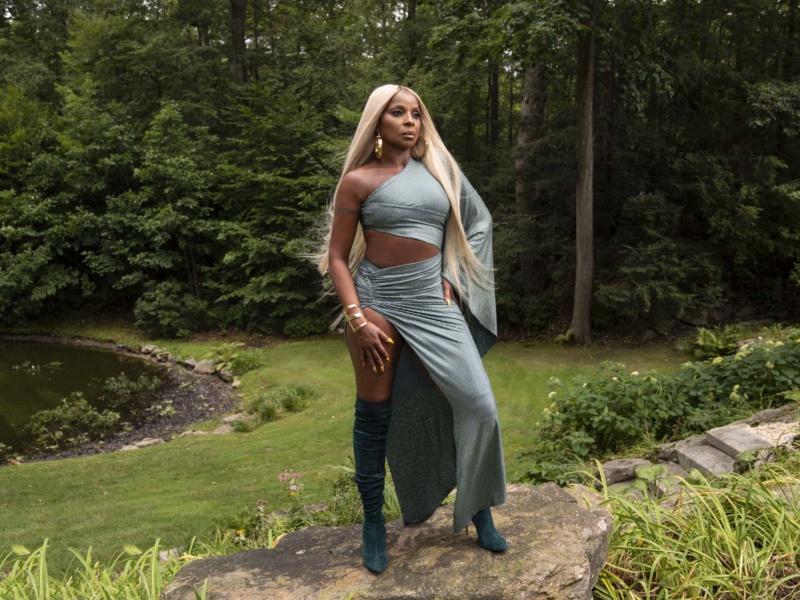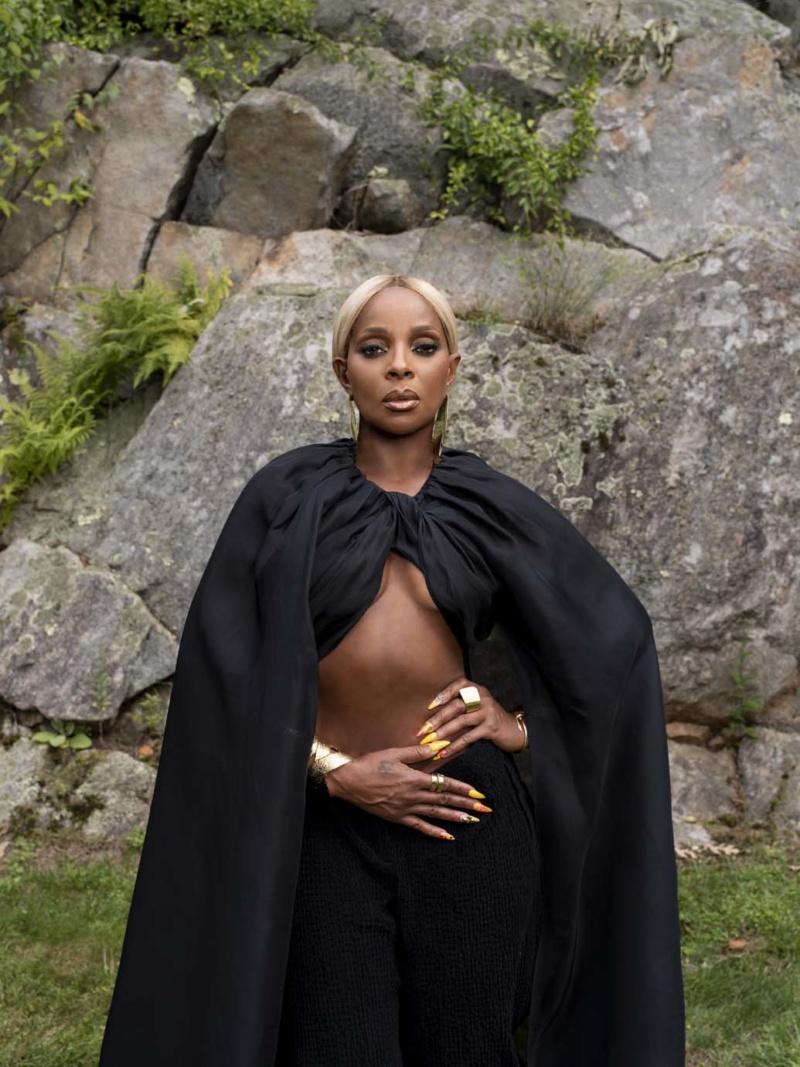
Senator Kamala Harris was making history. Standing at a podium in a plum pantsuit and flanked by American flags, the Black-South Asian politico was speaking remotely in Wilmington, Delaware to millions of Americans at last month’s virtual Democratic National Convention, where she officially accepted her Vice Presidential nomination. The first Black woman to do so, Harris used some of her twenty-minute remarks to credit the Black female suffragists who paved the way for her to stand squarely at the center of American politics nearly a century later. It was a testament to the enduring and unrecognized influence of Black female political resistance and, when Harris closed, she seemed to double down on her point. Rather than the sound of rapturous applause, what was immediately heard were the brassy vocals of none other than Mary J. Blige.
The R&B siren’s 2007 “Work That” was the soundtrack to this momentous occasion, the anthem preaching the value of self-worth, female empowerment and self-actualization. “There’s so many-a girls/I hear you been running/From the beautiful queen/That you could be becoming…” the inspirational lyrics went on as Harris waved to the small, socially-distanced delegation assembled before her and a gaggle of supporters beaming in via Zoom. A campaign song, as we know, is a thoughtful measure, a rallying cry meant to incite the audience, appeal to would-be voters and send coded messages to one’s opponents. By centering Blige’s “Work That” in one of the biggest game-changing moments in American politics, Harris seemed not only to pay homage to Black womanness but also to unite the culture’s two proverbial favorite aunties. Immediately, Black Twitter erupted in celebration.
“Kamala Harris. It was the Mary J. Blige ‘Work That’ at the end of her speech for me…,” radio host Charlamagne Tha God declared.
“We heard Mary J. Blige at the end and we heard a Divine 9 shoutout at the beginning,” activist Brittany Packnett tweeted, referring to the Queen of Hip Hop Soul and Harris’s AKA sorority affiliation. “That is certainly never something that many folks in our community thought they would see.”

That a mere snippet of a deep cut Blige track would rouse such visceral reactions (Blige’s name quickly began to trend alongside Harris’s on social media) says so much about the polymathic force’s unflagging twenty-eight-year reign and relevance in the entertainment industry. Rising up from a traumatic childhood spent in the Schlobohm projects of Yonkers, New York, where Blige endured abuse and a broken family, the young creative would go on to be signed by late music executive Andre Harrell of Uptown Records at just eighteen and mentored by a young Sean “Puff Daddy” Combs. Entering into the cultural imagination in 1992 as a soulful tomboy with platinum locks and combat boots, Blige’s trailblazing debut What’s the 411? changed Hip-Hop, as she melded the thumping beats of the genre with the earnest, pleading lyrics of R&B on her hit single, “Real Love.” This amalgamation of the raw and vulnerable would become her oeuvre; like a pained but streetwise Nina Simone, Blige swiftly entered into the pantheon of moody chanteuses who could pull on one’s heartstrings with just a few notes. Superstardom would follow, along with fifty million albums sold, nine Grammy wins and, eventually, two Academy Award nominations.
But turmoil ran alongside her massive fame, with Blige publicly battling drug and alcohol abuse, rocky personal relationships, a brutal divorce from her ex-husband and former manager and dizzying financial problems. These challenges fueled her work, with Blige filtering her pain into the diaristic lyrics she penned across her thirteen albums. The singer never shied away from her feelings; she was a tender artist who could pierce through the emotional center of a moment with absolute and stunning clarity.
Whether she’s declaring she’s “Not Gon’ Cry” on the ballad of the same name from the seminal 1995 Waiting To Exhale soundtrack, shrugging off the haters in the “dancerie” or giving herself completely over to a relationship on the transcendent “Everything,” Blige easily makes plain ineffable feelings. But while being in touch with such a raw emotional space is how Blige became a legend, it’s a knowingness that surprises even her to this day, she tells me last month over the phone from her New Jersey home.
Recounting how she recently sat down to listen to the title track off her timeless breakthrough sophomore album, My Life, which celebrated its twenty-fifth anniversary this past July, Blige says wistfully, “I’ve performed it so many times. But one day I was listening to it, and it’s the part where it says, ‘Take your time, one day at a time. It’s all on you, what you going to do?’ I just started crying because I’m like, ‘Who wrote that?’ Back then, I was messed up and I wrote that.” Talking about this revelation now stirs up goosebumps for her. “It’s crazy because I keep listening to myself like a fan almost. Like, ‘Oh snap, I didn’t even know I even said that.’”

But, learning about her writing methodology, it would seem that nuggets of truth like these pour out of the artist. While waiting out the quarantine brought on by the international COVID-19 pandemic these past few months, she tells me she would wake by 3AM to write, then drift back to sleep and eventually rise at 8:30. Poetry, letters, even commencement speeches flowed from her in these early hours and onto the Notes section of her iPhone, where she compiled her thoughts. “I wake up in the morning writing and praying—I’m in that whole spiritual thing in the morning. So when I’m there, all types of things are coming. It’s just amazing. Especially when there’s so much quiet. When everything got still the writing went crazy.” The quiet of lockdown and her dedicated meditation practice brought her a rush of clarity and ideas, manifesting ten songs that speak to the current state of the world. “I hope a lot of people could see that, at the end of the day, it doesn’t matter what your status is; we have been broken down to understand that we are all in this together and we should never look down our nose at anybody or say that we’re better than anyone just because we have more money or we have more this, because COVID is the great equalizer,” she opines.
Quite honestly, a new album from Blige couldn’t arrive at a better time: Who else to provide a life raft for so many hurting in this present moment of civil unrest? In fact, there is so much creative output, the singer reveals, she may have enough to produce a book, or even a TV show. Always a scene-stealing performer (in Blige’s evocative live performances, the singer embodies any number of alter-egos: jazz diva, gospel chorus leader, Hip Hop MC), the singer in recent years has shape-shifted into an arresting and commanding screen star. Dubbed one of the industry’s top Black leading ladies by T Magazine last spring, she joins the ranks of behemoths Angela Bassett, Halle Berry and her best friend, Taraji P. Henson. That evolution may seem swift, given that Blige came to acting success later in her career, but, as she explains, landing feature roles was something she had been working towards for years. Getting her start in a 1998 appearance on The Jamie Foxx Show, followed by a lead role in Prison Song with Q-Tip in 2001, Blige quietly racked up screen time and steadily perfected her craft. “I always wanted to look and be somebody else in that acting role, not Mary J. Blige,” she explains. “So I just kept working at it, and every time a job came I took it seriously, worked hard, and here I am, where people seem to really like what I’m doing.”
That is perhaps an understatement, considering her breakthrough performance in 2017’s Mudbound would garner the attention of Hollywood and earn Blige two Academy Award nominations—Best Supporting Actress and Best Original Song for “Mighty River.” It’s one of those career-defining depictions wherein the artist simply slips away and subsumes the role. Gone are the Mary J. Blige signifiers—golden-hued tresses, glittering hoop earrings and come-hither thigh-high boots. Instead, the singer fully gave herself over to the character of “Florence,” the wife of a sharecropper in post-World War II Mississippi. She appears at home here, with preternatural instincts for the dramatics, but Blige confesses the shift from concert stages to a film set was daunting. “I definitely feel like I had to work harder because I am a singer. People give things to singers because they’re singers—it’s like throwing them in a music video. I didn’t even want to look like I was just thrown into a music video. I wanted to make my sisters like Queen Latifah and Taraji [P. Henson] and Angela Bassett, and all the women who had been in the film business and suffered and gone through so much to get these acting jobs, see that it’s not a game for me.”
Henson and Latifah were easily convinced of their best friend’s prowess. “I was shooting Mudbound and I went to Queen Latifah and Taraji because I was so petrified that it was such a big responsibility,” Blige recalls. “I was number three on the call sheet or something like that. And I was in the movie carrying it, as this mother. So I called Taraji and I was like, ‘What do I do? How do I just fall into this character?’ And she was like, ‘Mary, you always had it, baby. You got it.’” Falling into character, as she describes it, is becoming increasingly more the norm, with Blige now poised to grace the smaller screen as “Monet,” a steely drug queen-pin who lords over a family narcotics operation in Power Book II: Ghost, the widely anticipated spinoff to 50 Cent’s mega-hit, Power.
Blige tells me she knows this character well, having grown up with and befriended women in her native Bronx and Yonkers neighborhoods who, out of a will to survive and withstand their impoverished surroundings, had gotten caught up in “the life.” “I have my girlfriends today—they don’t do it anymore—but they did it to survive, they did it to raise their children. They were Monet. And now they’re women with regular jobs and their kids are big. But some of them have lost their children to drug gangs and for some reason, when I was younger, I always hung out with older women. And those women were Monet.” In advance previews, I admittedly gasped when Blige arrived on camera, swinging a mane full of red hair and a convincingly ruthless presence.
It’s a role that she can add to her growing CV, which also includes executive producer (Blige opened her own company, Blue Butterfly Productions, last year after signing a first look deal with Lionsgate) and, as of late, wine entrepreneur. Blige becomes audibly excited to discuss the launch of Sun Goddess, an original duo of a pink-hued pinot grigio and a sauvignon blanc that will most likely become constants in the fridges of aunties everywhere. Two gilded bottles appeared at my house a few days before our conversation and I quickly imbibed the collaboration between Blige and Fantinel Winery CEO Marco Fantinel. The two met by chance one night three years ago after Blige performed on tour with friend and fellow artist, Maxwell. The wine impresario asked Blige if she had ever considered creating her own line; the singer, something of a connoisseur, hadn’t, but she didn’t hesitate in taking the proposition seriously. Soon she was traveling to Friuli, Italy for an immersive three-day experience of tasting and pairing with Fantinel, and Sun Goddess was born; the moniker is a nod to the nickname Blige’s sister gave to her passion for soaking up rays whenever they vacation. True to form, Blige posted images of herself enjoying a glass poolside this past summer, the sun drenching her incredible physique and reflecting off her wrap-around shades.

With authenticity always front of mind, Blige assures me that this isn’t a product she simply slapped her name on (the bottle boasts her signature “MJB” branding on the cork). “I don’t play those games. Let me tell you something, and I know I might sound crazy when I tell this story: Someone came to me years ago with a deal for some kind of beauty product. It was a lot, a lot of money and I turned it down. I said, ‘Because I don’t use it.’ I love my fans, I love women, I love us too much to act like I’m using this for a whole bunch of money and then they get it and then they break out, or something like that.” Even as Blige evolves—singer, actress, executive producer, vintner—authenticity remains a mainstay and a business principle.
She had to learn quickly, after her divorce left her financial future uncertain. It was a devastating blow. “I felt like I made the biggest mistake of my life. I’d seen my life in somebody’s hands—not just my life, but my business. Just my whole entire life entrusted to someone who just didn’t care about it at all. And it showed, and the world saw it. So, when it was done, it was like, ‘Okay. I’m responsible for that. I’ll take that. That was my fault, I created that monster. I put my whole life in somebody’s hands.’”
Dumbfounded by having to pay out a significant sum of money in alimony (“I got hit with all the alimony, which just had me like, ‘I can’t believe this happens to women, I just can’t believe this’”), Blige began meeting with business managers until she found the right team to help guide her towards prosperity. Rather than running her business like a large conglomerate, she tells me she wanted to scale down so that she could have more control over the everyday. She also learned the ins and outs of every facet of her business. “No matter who’s working for me or who does this and who does that, I’m going to know some of what they know.” She never wanted to be in the dark again. The term “survivor” gets thrown around so much to describe Blige, but how else to relate her staying power?
That earnest drive to rebuild for her future is what ultimately makes Blige’s successes all the sweeter now. Take the BET Lifetime Achievement Award she won last year: before performing a nearly twenty-minute medley in front of a room of industry peers and visionaries (including a leather-clad Rihanna, who presented her with the honor and thanked the artist for paving the way for her own career), Blige held back tears. “People always ask how I sustain and stay relevant in this industry. It’s because, although I am a leader, a queen and a living legend… I’m a servant as well, and I’m here to serve. Being a servant is not always glamorous or popular, but it’s the job and the assignment that I was given.” Moments later, Blige wailed, bopped and famously two-stepped (her signature move that has produced thousands of memes over the years) through a survey of her career for adoring fans—a feat that left her young successors, such as Lizzo, slack-jawed in the audience.
When I bring it up now, Blige is still sizably moved. “That was an incredible moment. I mean, I needed it for so many reasons because I was coming through such a heavy time trying to get my life together, trying to do all of that, divorce. And to have that moment just to say, ‘I’m still healthy, I’m still strong, I’m still Mary, I’m still hot, I’m still fly, I can still dance my ass off, I can still sing my ass off,’ in front of my people—that was God.”










 in your life?
in your life?

